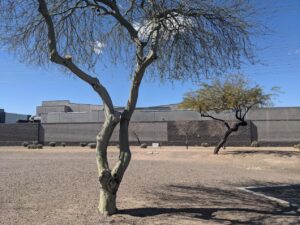We take you deep inside the hidden core of the new bubble: data centers. After 10 years exploring data farms in America, Singapore and beyond, Anthropologist Steven Gonzalez Monserrate published his paper “The Cloud Is Material: On the Environmental Impacts of Computation and Data Storage”. Then we tackle mountains of toxic waste rushed from Los Angeles fire zones with soil restoration expert Russell Taylor.
Listen to or download this Radio Ecoshock show in CD Quality (57 MB) or Lo-Fi (14 MB)
SHOW SONG “Data Farm” – lyrics by Alex Smith, AI Music, Creative Commons License (free for non-profit use) Listen to it – or download this 2 minute tune.
EXPLOSION OF DATA CENTERS
Like mushrooms after the rain, bland concrete buildings the size of football fields are popping up around the world. They guzzle electric power and water equal to small cities. There are a lot of reasons you need to know what is coming.
From the new American President to Microsoft to Amazon, everyone is announcing massive new data build-outs, up to half a trillion dollars for one group alone. In the corporate casino, these are sky-high bets. Some governments are betting your tax dollars and bank accounts too. Remember though, in just one week at the end of January, one new AI model from China knocked out a trillion dollars in stock value in a single day.
All this could crash much faster than 1929, now that machines make trades in less than a fraction of a second. AI promises everything but so far has created very little, including any profits. Pension plans for a billion people, all our banks, and our governments are totally invested in this. Belief in the new idols of artificial intelligence and geopolitical computing power puts our whole economic system at risk. We won’t have time to examine just how fragile this whole server farm gold rush really is, and this is not a financial program.
LOSING THE ENERGY REVOLUTION
We should also shudder at the new energy burden, just at a time when we need to slash carbon emissions or face climate disasters lasting generations. Already, coal plants due to close have been kept open just to run artificial intelligence or crypto currency mining. Major corporations promise to build new gas burning power plants right beside their mammoth server farms. Others plan to re-open antiquated nuclear plants for electricity. Microsoft’s Bill Gates is dealing to re-open the shuttered Three Mile Island, reactors right beside America’s first major melt-down. Those old General Electric Mark I reactors have known flaws that also blew up four nuclear reactors at Fukushima Japan. It is awe-inspiring dangerous lunacy. So there’s that.
Data Centers Drive Higher Forecasts for Electric Demand in Pennsylvania, Sparking Climate Worries
This new wave of demand for electricity will be larger than the addition of renewable energy. AI and crypto threaten to make all those solar panels and wind machines meaningless, lost in the new thirst for power. Unchecked by any authority, and boosted as the new economic miracle, it is a new threat to the climate of the world.
INSIDE DATA CENTERS
STEVEN GONZALEZ MONSERRATE
Beyond radio airwaves, these words travel through a vast network of computers, undersea cables, coolers, and fossil fuel burning, including coal. They call it “the cloud”. Where is the cloud and what does it cost the atmosphere and environment? Is it becoming a new life-form? What happens as artificial intelligence and bit coin mining succeed?

According to years of study by Dr. Steven Gonzalez Monserrate, “The Cloud now has a greater carbon footprint than the airline industry. A single data center can consume the equivalent electricity of 50,000 homes.” And we are just getting started, with a boom in server construction globally.
Dr. Gonzales is an Anthropologist of Cloud Storage. He is a Digital Sustainability Advocate. Steven has published in Wired, and Popular Science, and appeared on ABC News, the BBC and more. From MIT, Steven just took a new position as a Postdoctoral Researcher with the Fixing Futures Research Group. That is at Goethe University in Frankfurt, Germany.
Listen to or download this 36 minute interview with Steven Gonzalez Monserrate in CD Quality or Lo-Fi
The full paper “The Cloud Is Material: On the Environmental Impacts of Computation and Data Storage,” (2023) is here.
Steven went to big data operations in several U.S. states, as well as Singapore, Iceland, and his native Puerto Rico. As a professional ethnographer, he gained access into the holy of holies, inside server farms. But he writes not just about circuit boards and wires: there are people working high-stress jobs, the “farm” workers or “people of the cloud”.
There are all kinds of problems with this new architecture, human impacts, and grave environmental concerns. Steven says according to any measurement, the “cloud is a carbivore”. It eats carbon to be built. It belches carbon into the atmosphere just running all those computation machines. This new energy-hungry industry is sucking up any gains from renewables and jacking up rates for customers who now have to compete for electricity – like people in their homes.

COOLING THE CLOUD
The mirror image of deadly extreme heat developing all over the world, is an event in server farms where they overheat and shutdown. They call it a “thermal runaway event”.
The big draw it turns out, is not just electrons running around in the chips, but the bi-product of heat build-up. They must cool down big all that circuitry before it fries. One possibility: put all the computer farms in Iceland or northern Scandinavia, to get free cooling. Although there are data centers in Iceland, mainly for crypto-mining, this won’t work for today’s digital consumer. Even the milli-second lag transmitting from the near-Arctic to big markets like London, New York or Frankfurt, is too much. We want instant results as a consumer, and large institutions need very fast processing. The geographical solution is out for now. Too bad, as Iceland at least could provide clean geothermal power.

The news is filled with Chinese accomplishments with large-scale solar energy and wind. They also have big data centers and plans for much more. These energy-sucking plants are mostly running off coal, the most polluting fossil fuel, and a source of polluted air over China. None of that is good news. The Chinese have announced a new fleet of super-large nuclear plants to be constructed – not available now. Just imagine the power needed to run the shopping service Alibaba, or government surveillance programs, especially as artificial intelligence filters into almost every aspect of production and distribution.
Big American tech companies at first promised to run on renewables, or somehow make up for their carbon-belching. Now that seems out the window in the big race toward AI everything. Now they announce billion-dollar schemes to build gas generators, or even nuclear plants, as part of gargantuan data centers.
Everything in the Capitalist economy demands growth. Cloud technology is part of that system, and so likewise expects endless growth. Must demands for cloud hardware always expand? Can we reach a stable-state cloud?
MAYBE NOT…
A FAST CHANGE IN TECHNOLOGY OR SOCIETY MIGHT DERAIL THE DATA CENTER BOOM
Nothing in the future is certain, especially in this infant tech industry. We can imaging a number of scenarios where data centers present fewer problems:
The whole dream, or nightmare, of hundred-billion dollar server farms was shaken recently when a Chinese company developed AI using older chips and less energy. Maybe OpenAi doesn’t need StarGate.
Maybe quantum chips will reduce energy and cooling, although the few chips needed need be near absolute Zero, like -273.15°C or -459.67°F That would take energy.
Perhaps authoritarian governments limit AI use to their trusted workers, removing the burden of widespread public use of AI, and reducing data center harms. Or the economy could crash so hard nobody cares about online life. A solar storm could knock out the power grid, as could a war. The major tech companies could go bankrupt, having invested hundreds of billions of dollars but never producing a profitable product.
Note that Microsoft has withdrawn from leases in data-center space. But it isn’t clear what their data farm strategy is.
It almost feels like 50/50 odds whether this historic build-out of more data centers becomes real. If it does, we may all be so dependent on AI-driven systems, personally, in business, government, academia, entertainment, farming – that we accept whatever atmospheric and water damages from data farms. We become dependent, like a drug. Millions might starve without it. Military defense might not be possible without AI. “It” runs the system – until it discovers it can run us.
A LOT MORE TO STEVEN
Consider more than a decade carefully studying this digital land nobody explored. Steven observes and records like a scientist. He is also a science-fiction author, writing about possible futures under the pen-name E. G. Condé. He invented “Tainofuturism”. My shallow dive into Tainofuturism suggests it could allow hope, in spite of everything. His books include “Sordidez” – “about trauma, healing, and transformation in the wreckage of colonialism & climate disaster.”
Back in the United States, climate science and scientists are being eliminated. The new Administration is trying to suppress gender expression. Tech giants who run those farms Steven monitored have literally taken over the government, as neo-colonialists and worse. Steven just changed from MIT to Europe . He’s working with the “Fixing Futures Research Group at Goethe University in Frankfurt. In the interview I ask: does he feel like a refugee?
========
CLIMATE NEWS TIDBITS
Before we go the case of burned out Los Angeles and soil scorching, I want to pass on just a couple of bits of climate news. No one else is going to tell you. News and social media has been consumed up by the drama of American politics. Meanwhile, Nature continues to change radically as more greenhouse gases pour into the atmosphere.
Example 1: So-called “zombie fires” have taken a new twist. Enormous wildfires in the far North have continued burning under the snow in recent years, flaring up again in the Spring. Now Canadian fire expert Mike Flannigan reports “In 2024 a significant portion of BC area burned was due to 2023 fires that survived the winter…[This is the] First time I have seen fires survive two winters in Canada.” Friends, we are entering a time of never ending fires.
In 2024 a significant portion of BC area burned was due to 2023 fires that survived the winter (see figure on the left side). The current fire situation is on the right sidewildfiresituation.nrs.gov.bc.ca/mapand some are 2023 fires. First time I have seen fires survive two winters in Canada.
— Mike Flannigan (@mikeflannigan.bsky.social) 2025-02-24T18:37:20.340Z
Number two: new science shows the super greenhouse gas methane – geologic methane or natural gas – is coming out of glaciers in Svalbard. Those glacier are melting fast. It operates similar to fracking for geological gas and so it is called “Glacial Fracking”. Is this happening in fast-disappearing Greenland ice or Antarctica? This is a whole new frontier of methane emissions, never known or counted by scientists or governments when the claim to plan for climate change.
By the way, the high Arctic island of Svalbard, just 700 miles from the North Pole, had a string of days in February where it was above freezing – never seen before. This Arctic region is warming 7 times faster than the global average. As a result, rain froze into a glassy cover that prevents reindeer from pawing their way down to food this time of year. There could be starvation there.

The UK Arctic Research Station located in Ny-Ålesund, Svalbard – the northernmost permanent settlement in the world. The building is being moved off its foundations because it is sinking into the thawing permafrost.
Finally, lost in the buzz of Musk-madness and war stories, Arctic sea ice is already at a record low – in January when it ice should be expanding. That feed-back that can only strengthen in 2025.
Oh yeah, in the sort-of-good-news department, new science calculates the new ice age should begin in about 11,000 years. That won’t happen because human-generated carbon remains in the atmosphere for over 100,000 years. Cancel one Ice Age, if our species manages to survive that long.
[“Distinct roles for precession, obliquity and eccentricity in Pleistocene 100kyr glacial cycles” by Stephen Barker et al. Science]
==============================
RESTORING SCORCHED SOIL
California Governor Gavin Newsom reported by February 17th, – 7,100 residential parcels in Los Angeles burns were cleared were of household hazardous waste. Really? The incoming Trump Administration slashed environmental protection standards to make that happen. Only the top six inches of toxic ash are being removed, no measurements taken, and toxic waste is being spread over famous beaches for sorting. In fact, we don’t know much about soil in burned out cities, or even how to restore millions of acres burned by wildfires each year in America alone. We need to look deeper.
SOIL RESTORATION EXPERT RUSSEL TAYLOR
The Los Angeles Times reports:
“Army Corps officials are saying that excavating six inches of topsoil is enough to rid fire-devastated properties of hazardous pollution. The decision surprised L.A. County officials. The U.S. Army Corps of Engineers said Wednesday that it won’t order soil testing at properties damaged by the Eaton and Palisades fires after they have been cleaned by private federal contractors – breaking with a long-standing safeguard to ensure no lingering contamination is left behind after wildfires.”
As California author and journalist Susie Cagle @suze.bsky.social notes on BlueSky:
“So many people are going to suffer for a generation, if not more, because of the breakneck pace every level of government seems intent on pushing in this recovery.”
We have so much to learn about what happens to soil and soil life when cities burn, and forests burn, in this newly overheated world.
Listen to or download this 18 minute interview with Russel Taylor in CD Quality or Lo-Fi
Winter fires in New Jersey and the Carolinas. Canadian towns burn down and then part of Los Angeles is wiped out by fire. It is the same in many parts of the world. Remember the Greek fires just last year? It has come to this: all of us need to understand how to care for land after the wildfire. Your beloved home site may be toxic. The soil can be burned dead. The wind will spread particles of ash huge distances for weeks or months afterwards, making this everybody’s problem. What can be done?

Russell Taylor is a soil expert. Headquartered in Utah, he does soil restoration for a living. Russell knows how dirt works, before and after fires. He is Vice President of Live Earth Products in Utah. We reached Russell at the 2025 World Ag Expo in Tulare California.
===========
OVER AND OUT
I’m Alex Smith. Thank you for listening, hanging in there, and still caring about this world.